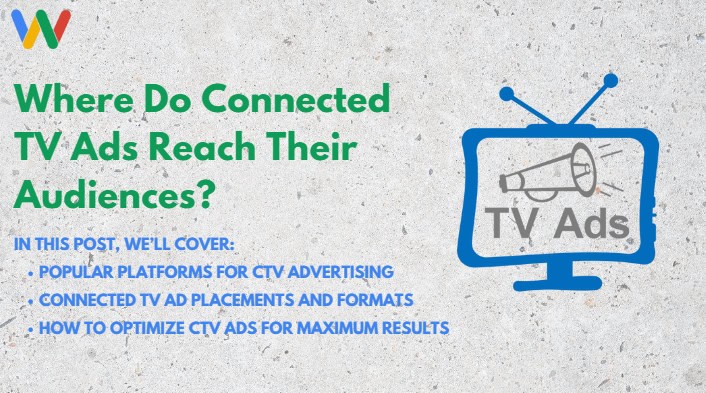Thanks to the domination of digital streaming services, television advertising is experiencing a drastic shift.
Table of Contents
As the popularity of traditional TV continues to decline, smart advertisers are turning to CTV ads to promote their businesses and boost brand awareness.
But, where do connected TV ads reach their audiences? How do advertisers find their audience on CTV devices and reach the right ones?
Answers to these questions will help you understand why CTV advertising is the future and why you should focus on this channel above the traditional TV ads I used to sell earlier in my career.
I’m Amy Gable and I’ve spent decades working in television advertising watching the industry morphing into what it is today. From the days of commercials interrupting your favorite shows to the rise of DVRs and ad-skipping, I’ve seen it all.
In this post, we’ll discuss:
- Popular platforms for CTV advertising
- Connected TV ad placements and formats
- How to optimize CTV ads for maximum results
Let’s dive into the highly-targeted world of connected TV ads.
Where Do Connected TV Ads Reach Their Audiences?
There are two angles to this question.
One would be the platforms where CTV ads are delivered. Second, the places and formats these ads appear on those platforms.
Let’s talk about both separately.
Platforms for Connected TV Advertising
Knowing how CTV advertising works will help you understand how these ads reach their target audience.
Unlike traditional TV ads, CTV ads give advertisers more control over ad delivery, placement, and formats.
The CTV advertising model lets you showcase ads based on viewers’ preferences and historical data.
They show up before, within, and after the main content on a CTV device like a smart TV or phone. It’s amazing how CTV advertising can reach audiences on their preferred devices.
But, before we dive into ad placements and formats, let’s talk about the platforms they’re used on.
The Major Streaming Services
Connected TV ads are shown on streaming services like Netflix, Hulu, and Amazon Prime Video.
These streaming services host a wide variety of content, allowing advertisers to reach a diverse audience.
From TV shows to movies and even games, people can enjoy a range of content types on these streaming services. And with CTV advertising, advertisers can now reach these viewers in a personalized and targeted manner.
CTV ads typically appear before, within, and after the main content. But unlike traditional TV ads, you’re able to target very specific demographics and geographies, making your ad spend more efficient. For example, if you only wanted to serve ads to women between the ages of 25-34 in California who recently shopped at Target or Wal-Mart, CTV advertising allows you to do just that.
Video Hosting Platforms
There are some social platforms where users can host videos that feature CTV ads.
For instance, YouTube lets advertisers showcase ads before, after, and within a video. And YouTube often comes pre-installed on televisions sold in retail stores, making it a great option for advertisers.
These can either be skippable or non-skippable video ads.
Now that you know where CTV ads show up, let’s talk about their placement and ad formats.
CTV Ad Placements and Formats

One of the major benefits of CTV advertising is that it lets you feature your business creatively. You can choose to showcase your ads in different ways.
Why is accurate ad placement important?
Because it lets you get in front of the right audience at the right time.
CTV advertising uses consumers’ viewing history to serve your ads at the right moment.
As a result, your ads are more likely to generate the desired number of clicks and conversions.
Your CTV ad’s format and placement determine its overall effectiveness.
Here are the most popular ad formats used on connected TV devices.
Video Ads
These ads are similar to traditional television ads. The only difference is that you have more control over their placement.
Based on that, video CTV ads are divided into three categories.
Pre-Roll: As the name suggests, a pre-roll CTV ad appears before the video content. Pre-roll ads tend to be less intrusive and don’t interrupt the viewing experience. They’re usually a few seconds long and are designed to capture attention instantly.
Mid-Roll: Have you ever been interrupted by a short video ad while watching a YouTube video? Of course, you have. Mid-roll ads are like in-stream ads that appear within the content, such as a Netflix documentary. With a mid-roll ad, you have a bit more freedom to get into the details of your offer and engage prospects.
Post-Roll: Appearing right after the main content, post-roll ads are meant to leave a lasting impression on the viewer. However, it can be tricky to generate conversions with this ad format since viewers are more likely to move on to a different activity and ignore the ad.
Overlay Ads
This CTV ad format appears at the top, bottom, or side of the screen.
Unlike video ads, an overlay ad doesn’t interrupt the viewing experience.
It can appear as an image or an animation on top of the main content.
You can add interactive or clickable elements to overlay ads and drive traffic to an external page.
This makes overlay ads perfect for lead generation.
Related: Can You Link from an Ad on OTT Platforms?
Banner Ads
Banner ads appear at the top or bottom of a video. They usually have the image of the product, a piece of copy, and a call to action. You can use banner ads to drive traffic to a landing page through clickable elements.
Optimizing CTV Ads

Gaining success with any advertising campaign involves audience research, testing, and optimization. At Webology, I help plan, execute, and optimize CTV ad campaigns to ensure maximum ROI for my clients. I use advanced targeting options to reach the right audience and continuously monitor and adjust the ads for better performance. But it all starts with audience research to make sure we are targeting the right crowd.
Audience Research
Understanding your audience should be one of the first things you do as an advertiser.
Only when you know your audience can you craft result-oriented campaigns.
So, gather data on your audience’s demographics, psychographics, and online behavior. Research their interests, media consumption habits, and preferred devices. This will help you create a more personalized and effective ad campaign.
Testing Different Formats
Testing allows you to identify winning ad creatives and placements.
For instance, you may find out that placing an overlay ad with a clickable CTA at the center of a content piece generates a maximum number of clicks. Or, you may find out that using a video ad instead of a static image leads to higher engagement.
By testing different formats, you can also determine which ones resonate best with your target audience. This will help you optimize your campaigns and allocate your budget more effectively.
Track Key Metrics
Monitoring your KPIs (Key Performance Indicators) helps you focus on the right strategies.
Key metrics to track in CTV advertising are:
- View-through rates
- Click-through rates
- Engagement
- Conversions
By staying on top of your performance, you can make data-backed advertising decisions and achieve better results.
Where Do Connected TV Ads Reach Their Audiences: Conclusion
Connected TV is the present and future of content consumption. It beats traditional TV in terms of targeting, reach, and engagement.
A big reason to use CTV ads is the flexibility they provide regarding placement. You can serve up ads on a variety of streaming devices, including smart TVs, gaming consoles, and streaming sticks.
Connected TV audiences see these ads before, within, or after a piece of content.
Based on that, video ads are divided into pre-, mid-, and post-roll.
Other popular ad formats are overlay ads and banner ads. They can be interactive (or clickable) and appear anywhere on top of the main content.
CTV ads are typically shown on digital streaming services like Netflix, Hulu, and Amazon Prime Video. They’re amazing and you can use these ads to promote your business on smart TV apps like YouTube as well. Webology can help you create CTV ads and target the right audience for maximum impact. Reach out to us now for a personalized strategy and pricing quote.
You May Also Like: What are OTT Ads? 3 Reasons They’re the Future










